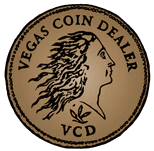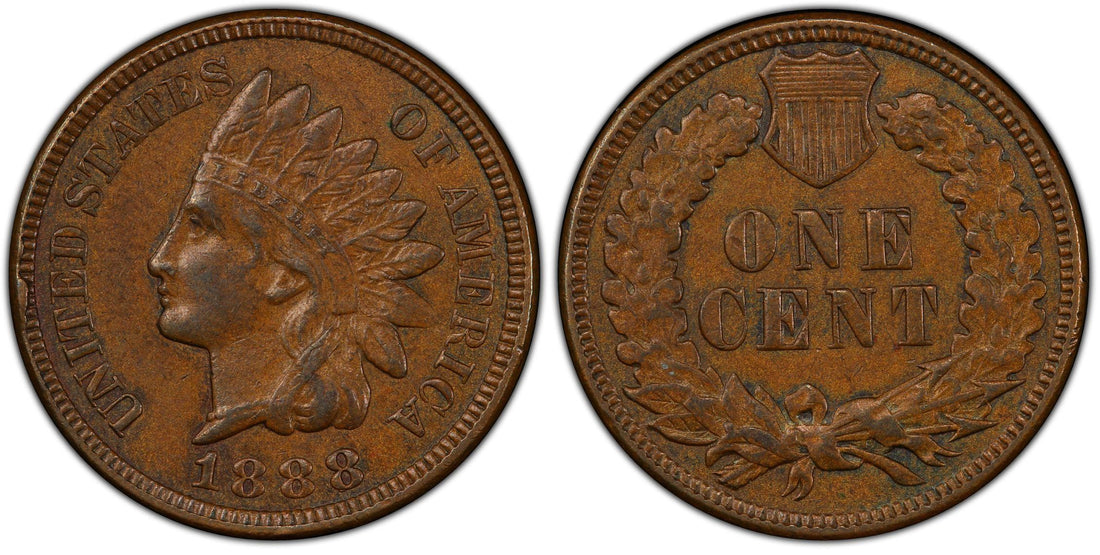Advice on Collecting Indian Head Pennies from an Indian Head Cent & Flying Eagle Cent Specialist.
Variety is the spice of life, and this statement couldn’t more aptly describe my obsession with Indian Head Cent varieties. My interest in these varieties didn’t come from coin collecting family members or attending coin shows at a young age, but rather fate. When I was 14 years old, I randomly stumbled across a YouTube video describing how rare errors in circulation could be found & cherry picked from regular bankrolls. I vaguely remember the title of the video was something to the effect of “$200 coin found in Pocket Change,” with the image of a 1999 Wide AM Lincoln Cent variety in the thumbnail. This piqued my interest enough to just forget about the video and find something else to entertain me. The next time I went out, I asked my mother to stop by a Chase bank so I could buy a roll of coins. Rolls eventually turned into boxes… Boxes turned into ordering multiple boxes per visit. And my mom was tired of taking me to the bank so I was hunting down pennies with my bike instead! (before I got my driver’s license)
On one of my roll hunts, I was working my way through a machine wrapped paper roll when suddenly a 1903 Indian Head Cent popped out! No, not a MS 65 Red example… but a wholesome Good 4 looking example. I had never seen an Indian Cent in hand before and my jaw dropped. I had purchased a red book by then and looked up the price of the coin. $2 was the estimated value. Despite the petty value, the significance of this moment could not be understated. It had unlocked an intense source of energy & curiosity towards this series (and eventually to the closely related Flying Eagle Cent series). I was hooked!
Since my early years of coin roll hunting, I gone on to buy, sell, and handle all the major & many collector-desirable varieties in the series (as well as numerous minor ones), done well over half a million dollars in transactions with them, and, through the process, developed a near encyclopedic memory of the intricacies for each variety. Cherrypicking and knowing the market for these varieties has been an invaluable skill set I’ve developed over the years. In this article, I hope to provide a general outline of what the major Indian Head Cent varieties are, why they are incredibly rewarding to collect, cherry pick, or both, and how to be an educated & opportunistic buyer in this constantly evolving space.
When you decide to explore Indian Head Cent varieties, you will quickly realize that there are literally thousands of published varieties in Rick Snow’s 2-volume, 900-page authoritative guide to Indian Head Cents. This is the book where I gained most of my knowledge about Indian Head Cent varieties and cannot understate how important it is to have and study religiously if you feel inclined like I am! PCGS has declared 5 of these varieties to be “Major Varieties,” which they deem are the most significant and are requirements in the popular Indian Head Cent with Major Varieties Registry set. I will focus on these for today, but in the future, will explore more of the many intriguing varieties in the series (which often are easier to be cherrypicked than the major varieties). These coins are the 1867/67 Repunched Date Snow 1, 1873 Doubled Liberty Snow 1, 1888/7 Overdate Snow 1, 1894/1894 Repunched Date Snow 1, and finally the 1897 1 in Neck Misplaced Date Snow 1. The range of values for these coins ranges from less than ten dollars to over one hundred thousand dollars for the finest known examples of the 1873 Doubled Liberty and the 1888/7 Overdate.




Image Courtesy of PCGS

Out of these 5 varieties, the 1867/67, 1894/1894, and the 1897 1 in Neck are relatively plentiful and relatively easy to acquire in lower grades up to AU 58. The price ceiling would be around 2k for each of these examples in premium AU 58 grade. The 1873 and 1888/7 are in a different league, with the 1873 Doubled Liberty being worth around 10k in AU 58 (example below in AU 58+ selling for $12,750 and the 1888/7 being worth $40-$50k in AU 58 (the 1888/7 below I sold for $45,000), with MS examples trending in the 20k+ range for the 1873 Doubled Liberty and 80k+ for the 1888/7 respectively.

Image Courtesy of PCGS

Image Courtesy of PCGS
What is important, however, is acquiring attractive examples, regardless of what price point you are collecting. One thing you will naturally find when collecting varieties is that dealers will often conflate the rarity of a variety with a high price. Translation: they will try to pass off ugly or low eye appeal coins for strong prices just because they are “scarce,” “ultra rarities,” and “less common”. Learn to develop a filter for these buzzwords and colorful descriptions from dealers and deceitful auction catalogers, and instead slowly learn what coins and what conditions these phrases deserve to apply to.
For example, I would rather purchase a gem AU 58 coin with traces of original mint luster, strong diamonds, and strong strike (especially on the first three feathertips) than buy an MS 62 example with carbon spots, a weak strike, heavy scratches, or relatively lack of eye-appeal. Attractive AU 58s in today’s market simply realize more than most MS 61, 62, and sometimes even 63 examples. Don’t believe me? Try finding strong money for lower graded MS coins that aren’t attractive from dealers or passionate collectors. It’ll be a challenge.
One important understanding in the variety space is that there is generally a relatively small, but highly passionate collector base. I’ve experienced that these collectors cluster around different segments. There is the AU 58s crowd, aka Everyman Set crowd, that has gained tremendous popularity in the last five to ten years. AU 58 is a very nice equilibrium between quality and value being within many collector’s ranges. AU 58s represent the finest quality you can get in a circulated coin, and the coveted AU 58+ has sent certain prices to absurd levels (a separate article there, in itself!). If you have the budget to collect varieties in AU 58 and below, I think this a tremendous value-centered approach & great place to focus. Then there are collectors that like to buy primarily mid-to-high grade mint state brown and red brown coins, often due to reasons of being inclusive towards a wide range of toning and eye appeal while also being much more affordable and arguably “better value” than fully red examples. Finally, there are the higher rollers dealing only in RDs, both for a regular registry set, but also for the varieties that are the most expensive and realize the massive 5 and 6 figure plus prices. There is nothing wrong with collecting varieties in all grades and conditions, but focusing on a particular grade or color range will help you focus on procuring quality and exceptional examples!
Let's look at an important example: the 1873 Doubled Liberty. This is considered the “King of Indians” due to the impressively dramatic doubling on all letters of LIBERTY, the eyes, nose, lips, and feather veins. These are worth around $500 to 1k in Good to Fine condition, around 2k to 4k in VF to XF condition, 4k AU 50 to 10k in choice AU 58 condition, and 15k and up to over 100k in MS 65 RB and MS 64 RD (only 1 known there). Having a nice one of these is a crown jewel in a serious variety collection or a competitive IHC with Major Varieties registry set. However, this is an easy variety to make mistakes in as a collector and get poor value for your hard earned dollar. Around half or more of these doubled liberty’s don’t come with all 7 letters of LIBERTY fully struck and outlined. Many come with a couple middle letters struck weakly or missing, sometimes more! Look at these examples below. From my experience, this issue comes with a plethora of contact marks and scratches, even on gem mint state examples. Many VF, XF, and AU examples are over-graded and are rather rough looking, thus realizing low auction prices and being kicked around from dealer-stock to dealer-stock and auction-house to auction-house, often pitched at a strong price for a gullible or less knowledgeable collector to bite.



Image Courtesy of PCGS

If buying an 1873 Doubled Liberty in grades where you can see LIBERTY, I would strongly suggest buying an example with a fully struck Liberty, with surfaces that will likely inevitably have home some contact marks but as minimal as possible. Landing an eye-appealing, grade appropriate example should be more important before you think about the price it's being offered at. Moreover, if you can cherry pick a really nice example priced similar to “market comps” of shoddy examples, that is a victory and something to relish in. When you are finished with your example, assuming a reasonable market and longevity in the variety collectors base, you can expect to at least breakeven or likely make a profit selling to a knowledgeable dealer or even better, a fellow collector.
I have been fortunate to handle some exciting examples, including two AU 58 examples as well as a gorgeous MS 64 RB example for this epic variety. However, I started off my learning and experience with a cleaned, ANACS G-4 net grade example that you could only make out the doubling on the eyes, lips, and nose. I have passed on dozens of examples I’ve seen at shows and auction sites due to lack of eye appeal and technical quality, and I would suggest you do the same as a collector, dealer, or cherrypicker.
Many coins out in the market are overpriced and have poor quality. One of the reasons you see extremely-high, realized prices is because at certain grade levels, often AU 58 and above, there is tremendous competition for very few quality coins that make the cut, and often more than don’t exist yet to the market. For myself, as a dealer making a living, looking for and making examples near the top of the population census (Top Pops) by catering to a very small and high level collector base is the most profitable way to deal in varieties. However, most of us don’t have the bankroll to play this very expensive game. My goal here is to help any collector maximize the value of their dollar when collecting, and purchasing examples that are solid or exceptional for their grade. Additionally, targeting certain grades that more collectors are interested in is an important goal as well.
Finally, it is important to recognize that collecting varieties is playing the long game. Some of my best clients have been collecting Indian Head Cent varieties for over 30 years! You obviously don’t have to have this long of a vision when starting out, but remember, varieties will take many years to assemble a truly exceptional collection you’ll be proud of. The most important piece of advice I can impart to new variety collectors, cherrypickers, or both… is to enjoy the hunt & the thrill of the chase! Trust me, it can become an addiction.
Article By Eric Lindholm

